Detailed Analysis of Australian Economy: Current State & Future Trends
VerifiedAdded on 2023/06/13
|15
|2775
|284
Report
AI Summary
This report provides a comprehensive analysis of the Australian economy, focusing on key indicators such as government expenditure, investment expenditure, consumption expenditure, and net exports. It examines the current economic state, highlighting the country's steady growth driven ...
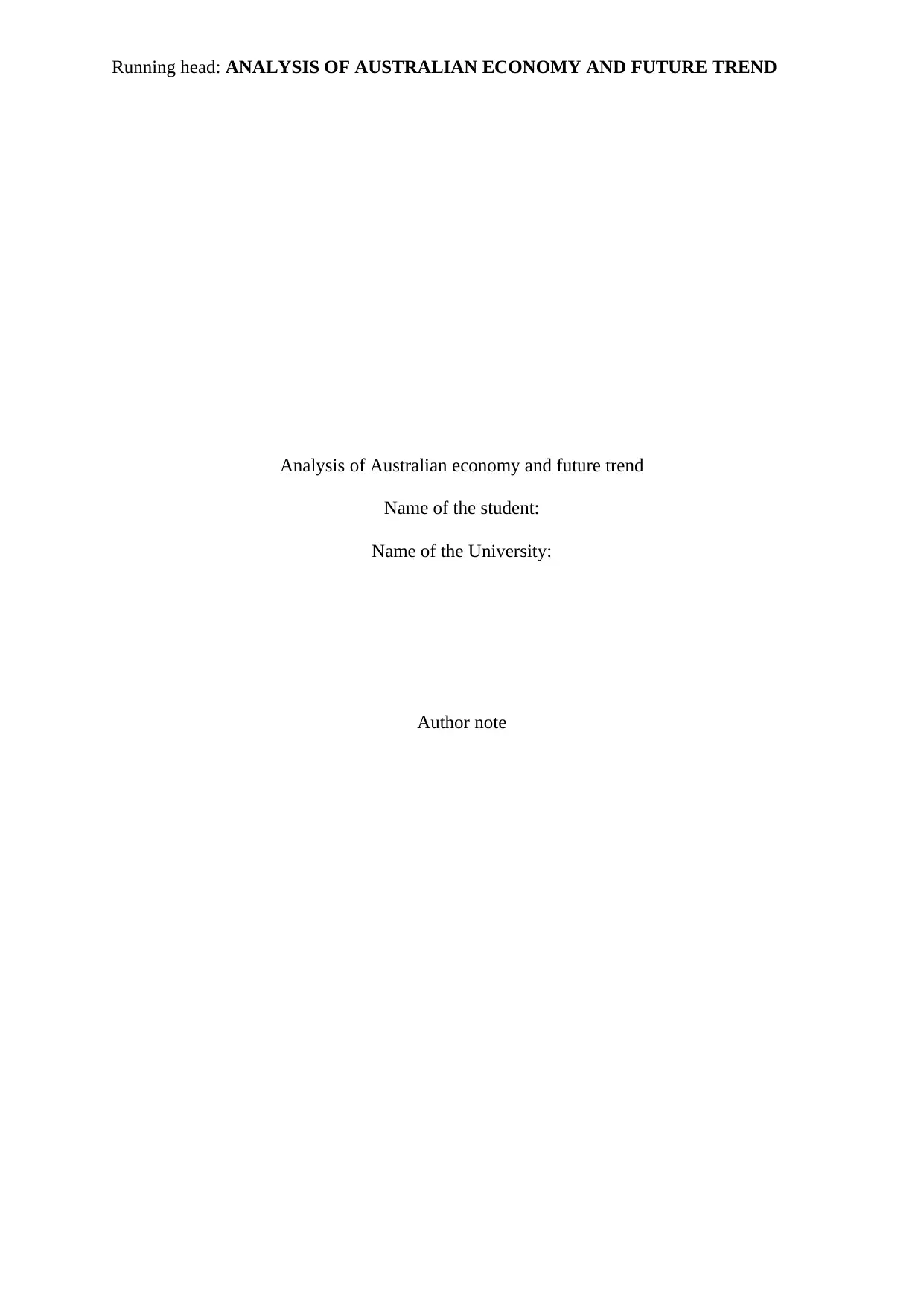
Running head: ANALYSIS OF AUSTRALIAN ECONOMY AND FUTURE TREND
Analysis of Australian economy and future trend
Name of the student:
Name of the University:
Author note
Analysis of Australian economy and future trend
Name of the student:
Name of the University:
Author note
Paraphrase This Document
Need a fresh take? Get an instant paraphrase of this document with our AI Paraphraser

1ANALYSIS OF AUSTRALIAN ECONOMY AND FUTURE TREND
Executive summary:
Australian economy is one of the largest growing economy in the world that has
possessed good amount of growth in recent days. This report is intended to argue the current
economic state of Australia with individual spotlight to the government, investment
expenditure, consumption expenditure and net export of the county’s economy. Next to this
the report is designed to present forecast of the Australian economy for coming six months
while depicting the justification for this forecast. From the analysis it has been observed that
due to recent mining boom and the rise in the government as well as public expenditure on
consumption the economy is sufficiently steady to resist any hasty surprise in the market. In
addition Australian economy has amplified at a sustainable rate over the last five years and
according to the projected growth path the economy will become a highly latent state. To
conclude it can be stated that though the economy has good growth of GDP, however, growth
rate was slow during the last one year. As the recommendation, the researcher argues in favor
of monetary expansion policy so that it can manipulate the growth of the economy to face
higher rate.
Executive summary:
Australian economy is one of the largest growing economy in the world that has
possessed good amount of growth in recent days. This report is intended to argue the current
economic state of Australia with individual spotlight to the government, investment
expenditure, consumption expenditure and net export of the county’s economy. Next to this
the report is designed to present forecast of the Australian economy for coming six months
while depicting the justification for this forecast. From the analysis it has been observed that
due to recent mining boom and the rise in the government as well as public expenditure on
consumption the economy is sufficiently steady to resist any hasty surprise in the market. In
addition Australian economy has amplified at a sustainable rate over the last five years and
according to the projected growth path the economy will become a highly latent state. To
conclude it can be stated that though the economy has good growth of GDP, however, growth
rate was slow during the last one year. As the recommendation, the researcher argues in favor
of monetary expansion policy so that it can manipulate the growth of the economy to face
higher rate.

2ANALYSIS OF AUSTRALIAN ECONOMY AND FUTURE TREND
Table of Contents
Introduction:...............................................................................................................................3
Australian economy analysis:....................................................................................................3
Consumption expenditure:......................................................................................................4
Investment expenditure:.........................................................................................................5
Government expenditure:.......................................................................................................7
Net export expenditure:..........................................................................................................8
Trend analysis of Australian economy:......................................................................................9
Conclusion:..............................................................................................................................12
Reference:................................................................................................................................13
Table of Contents
Introduction:...............................................................................................................................3
Australian economy analysis:....................................................................................................3
Consumption expenditure:......................................................................................................4
Investment expenditure:.........................................................................................................5
Government expenditure:.......................................................................................................7
Net export expenditure:..........................................................................................................8
Trend analysis of Australian economy:......................................................................................9
Conclusion:..............................................................................................................................12
Reference:................................................................................................................................13
⊘ This is a preview!⊘
Do you want full access?
Subscribe today to unlock all pages.

Trusted by 1+ million students worldwide
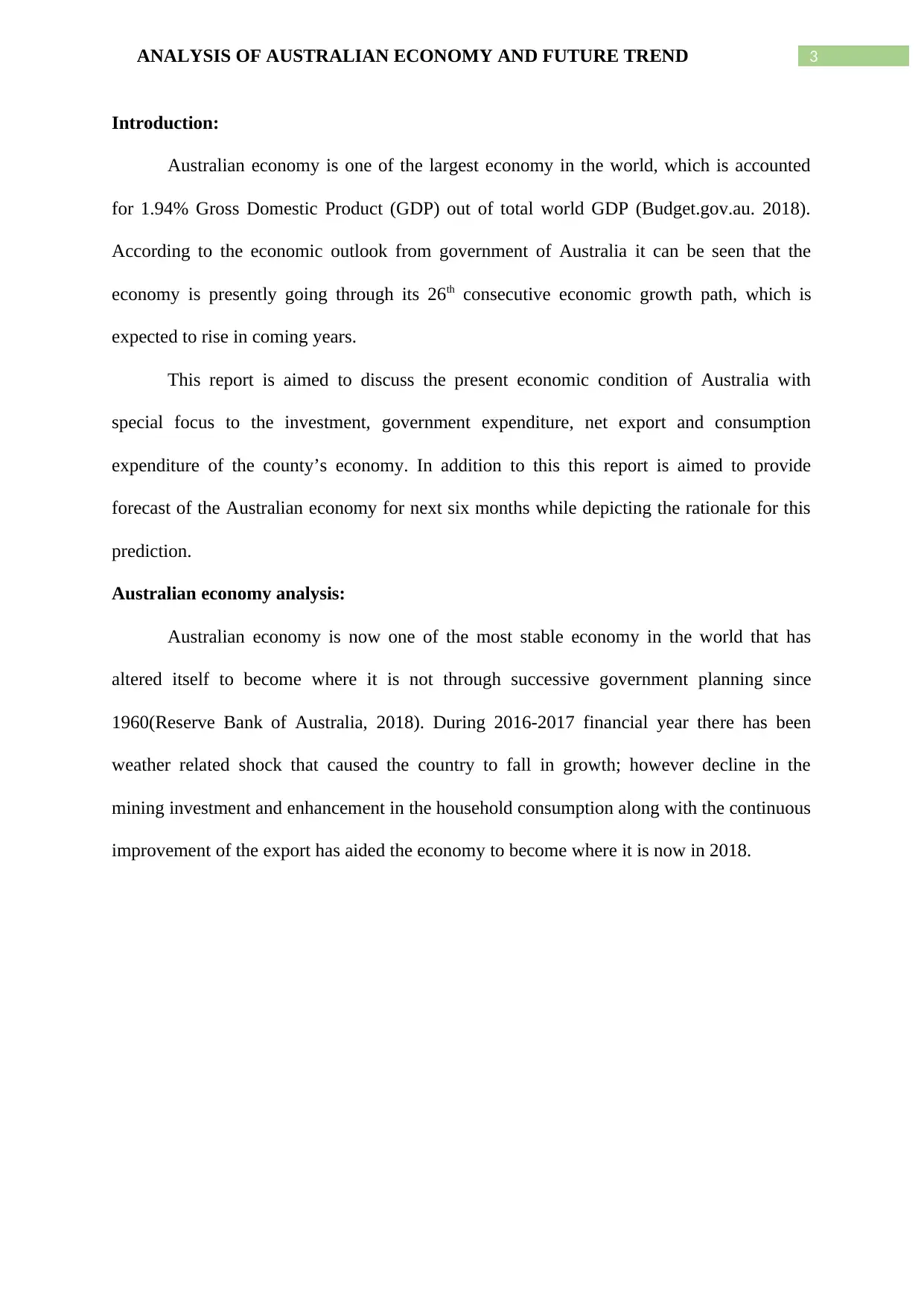
3ANALYSIS OF AUSTRALIAN ECONOMY AND FUTURE TREND
Introduction:
Australian economy is one of the largest economy in the world, which is accounted
for 1.94% Gross Domestic Product (GDP) out of total world GDP (Budget.gov.au. 2018).
According to the economic outlook from government of Australia it can be seen that the
economy is presently going through its 26th consecutive economic growth path, which is
expected to rise in coming years.
This report is aimed to discuss the present economic condition of Australia with
special focus to the investment, government expenditure, net export and consumption
expenditure of the county’s economy. In addition to this this report is aimed to provide
forecast of the Australian economy for next six months while depicting the rationale for this
prediction.
Australian economy analysis:
Australian economy is now one of the most stable economy in the world that has
altered itself to become where it is not through successive government planning since
1960(Reserve Bank of Australia, 2018). During 2016-2017 financial year there has been
weather related shock that caused the country to fall in growth; however decline in the
mining investment and enhancement in the household consumption along with the continuous
improvement of the export has aided the economy to become where it is now in 2018.
Introduction:
Australian economy is one of the largest economy in the world, which is accounted
for 1.94% Gross Domestic Product (GDP) out of total world GDP (Budget.gov.au. 2018).
According to the economic outlook from government of Australia it can be seen that the
economy is presently going through its 26th consecutive economic growth path, which is
expected to rise in coming years.
This report is aimed to discuss the present economic condition of Australia with
special focus to the investment, government expenditure, net export and consumption
expenditure of the county’s economy. In addition to this this report is aimed to provide
forecast of the Australian economy for next six months while depicting the rationale for this
prediction.
Australian economy analysis:
Australian economy is now one of the most stable economy in the world that has
altered itself to become where it is not through successive government planning since
1960(Reserve Bank of Australia, 2018). During 2016-2017 financial year there has been
weather related shock that caused the country to fall in growth; however decline in the
mining investment and enhancement in the household consumption along with the continuous
improvement of the export has aided the economy to become where it is now in 2018.
Paraphrase This Document
Need a fresh take? Get an instant paraphrase of this document with our AI Paraphraser
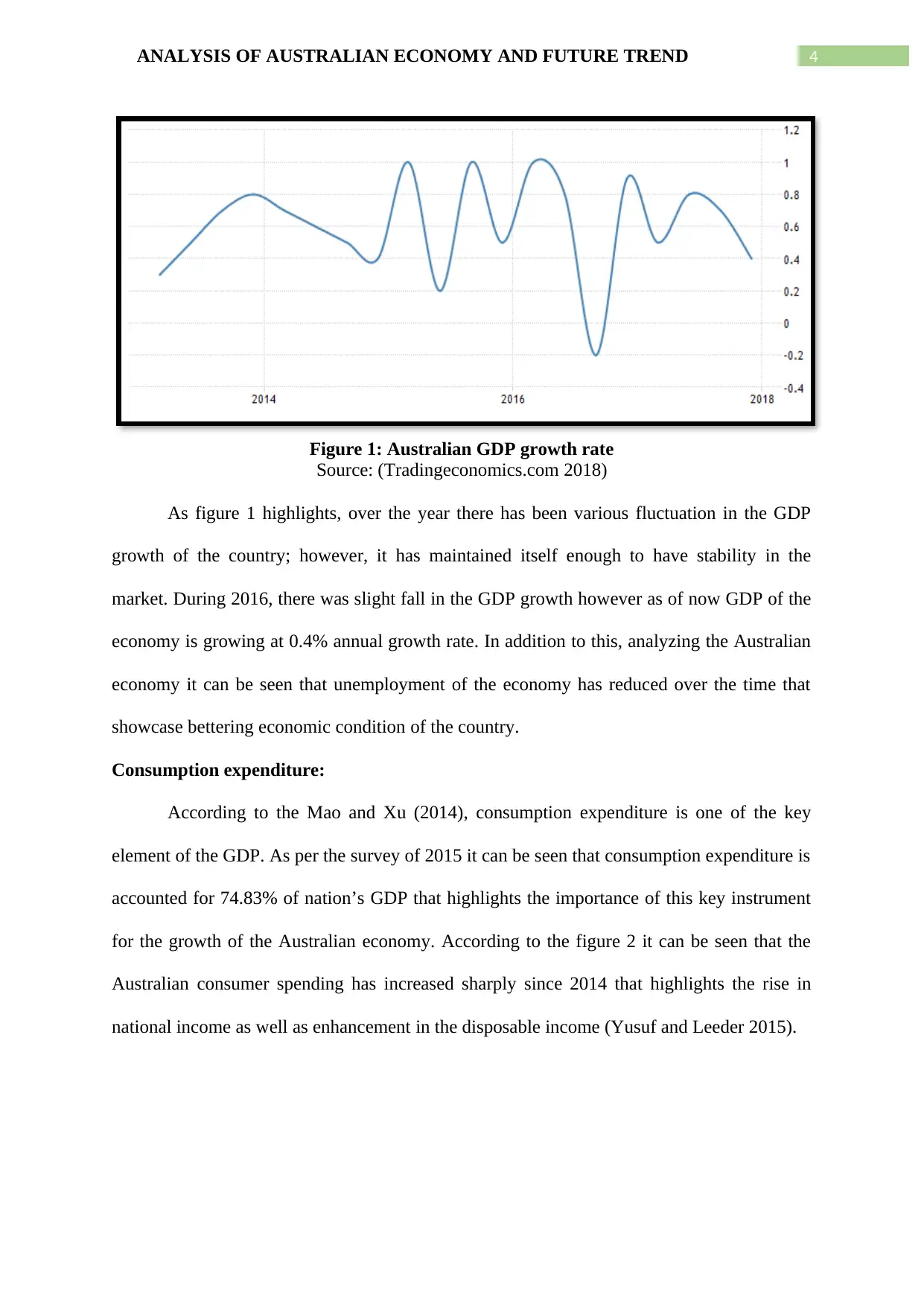
4ANALYSIS OF AUSTRALIAN ECONOMY AND FUTURE TREND
Figure 1: Australian GDP growth rate
Source: (Tradingeconomics.com 2018)
As figure 1 highlights, over the year there has been various fluctuation in the GDP
growth of the country; however, it has maintained itself enough to have stability in the
market. During 2016, there was slight fall in the GDP growth however as of now GDP of the
economy is growing at 0.4% annual growth rate. In addition to this, analyzing the Australian
economy it can be seen that unemployment of the economy has reduced over the time that
showcase bettering economic condition of the country.
Consumption expenditure:
According to the Mao and Xu (2014), consumption expenditure is one of the key
element of the GDP. As per the survey of 2015 it can be seen that consumption expenditure is
accounted for 74.83% of nation’s GDP that highlights the importance of this key instrument
for the growth of the Australian economy. According to the figure 2 it can be seen that the
Australian consumer spending has increased sharply since 2014 that highlights the rise in
national income as well as enhancement in the disposable income (Yusuf and Leeder 2015).
Figure 1: Australian GDP growth rate
Source: (Tradingeconomics.com 2018)
As figure 1 highlights, over the year there has been various fluctuation in the GDP
growth of the country; however, it has maintained itself enough to have stability in the
market. During 2016, there was slight fall in the GDP growth however as of now GDP of the
economy is growing at 0.4% annual growth rate. In addition to this, analyzing the Australian
economy it can be seen that unemployment of the economy has reduced over the time that
showcase bettering economic condition of the country.
Consumption expenditure:
According to the Mao and Xu (2014), consumption expenditure is one of the key
element of the GDP. As per the survey of 2015 it can be seen that consumption expenditure is
accounted for 74.83% of nation’s GDP that highlights the importance of this key instrument
for the growth of the Australian economy. According to the figure 2 it can be seen that the
Australian consumer spending has increased sharply since 2014 that highlights the rise in
national income as well as enhancement in the disposable income (Yusuf and Leeder 2015).

5ANALYSIS OF AUSTRALIAN ECONOMY AND FUTURE TREND
Figure 2: Australian consumer spending
Source: (Tradingeconomics.com 2018)
Better consumer confidence over the market ensure better economic growth. Figure 3
highlights the rising consumer confidence on the Australian market for last five years, which
has aided the economy to enhance its growth. Figure 3 highlights there has been various
fluctuation in the consumer confidence over the time, however, the economy has been strong
enough to hold it at a sustainable positiion (Atalay, Whelan and Yates 2016). Lowest
consumer confidence can be observed during 2015, when the economy faced another
recession due to natural shocks as well as shock in oil price.
Figure 3: Australian consumer confidence
Source: (Tradingeconomics.com 2018)
Figure 2: Australian consumer spending
Source: (Tradingeconomics.com 2018)
Better consumer confidence over the market ensure better economic growth. Figure 3
highlights the rising consumer confidence on the Australian market for last five years, which
has aided the economy to enhance its growth. Figure 3 highlights there has been various
fluctuation in the consumer confidence over the time, however, the economy has been strong
enough to hold it at a sustainable positiion (Atalay, Whelan and Yates 2016). Lowest
consumer confidence can be observed during 2015, when the economy faced another
recession due to natural shocks as well as shock in oil price.
Figure 3: Australian consumer confidence
Source: (Tradingeconomics.com 2018)
⊘ This is a preview!⊘
Do you want full access?
Subscribe today to unlock all pages.

Trusted by 1+ million students worldwide

6ANALYSIS OF AUSTRALIAN ECONOMY AND FUTURE TREND
According to the ABS data, there has been rise in household goods by 0.9% and the
sales has been increased by 0.8% during 2017 compared to the previous year (Reynolds et al.
2015). From this it can be seen that Australian consumption expenditure has been rising at a
sustainable speed, which is leading the economy towards sustainability in true sense.
Investment expenditure:
Investment expenditure is another important component that has influenced the
economy of Australia since decade. From the figure 4, it can clearly be seen that there has
been rise in the investment expenditure since 2016 and during the last quarter of 2017 it
started to fall again (Dwyer et al. 2014). Comparing this with the GDP growth of the
economy it can be seen that the GDP has reacted in the same fashion as the investment
expenditure that highlights the magnitude of correlation between this two factors.
Figure 4: Australia private capital expenditure
Source: (Tradingeconomics.com 2018)
Figure 5 highlights the interest rate of the economy, which helps to determine the
investment expenditure of the economy. It can be seen from the figure below that interest
rate of the Australian economy has been falling over the time that has enhanced the liquidity
in the market that has germinated higher demand and growth of the economy (Findlay and
Garnaut 2017).
According to the ABS data, there has been rise in household goods by 0.9% and the
sales has been increased by 0.8% during 2017 compared to the previous year (Reynolds et al.
2015). From this it can be seen that Australian consumption expenditure has been rising at a
sustainable speed, which is leading the economy towards sustainability in true sense.
Investment expenditure:
Investment expenditure is another important component that has influenced the
economy of Australia since decade. From the figure 4, it can clearly be seen that there has
been rise in the investment expenditure since 2016 and during the last quarter of 2017 it
started to fall again (Dwyer et al. 2014). Comparing this with the GDP growth of the
economy it can be seen that the GDP has reacted in the same fashion as the investment
expenditure that highlights the magnitude of correlation between this two factors.
Figure 4: Australia private capital expenditure
Source: (Tradingeconomics.com 2018)
Figure 5 highlights the interest rate of the economy, which helps to determine the
investment expenditure of the economy. It can be seen from the figure below that interest
rate of the Australian economy has been falling over the time that has enhanced the liquidity
in the market that has germinated higher demand and growth of the economy (Findlay and
Garnaut 2017).
Paraphrase This Document
Need a fresh take? Get an instant paraphrase of this document with our AI Paraphraser
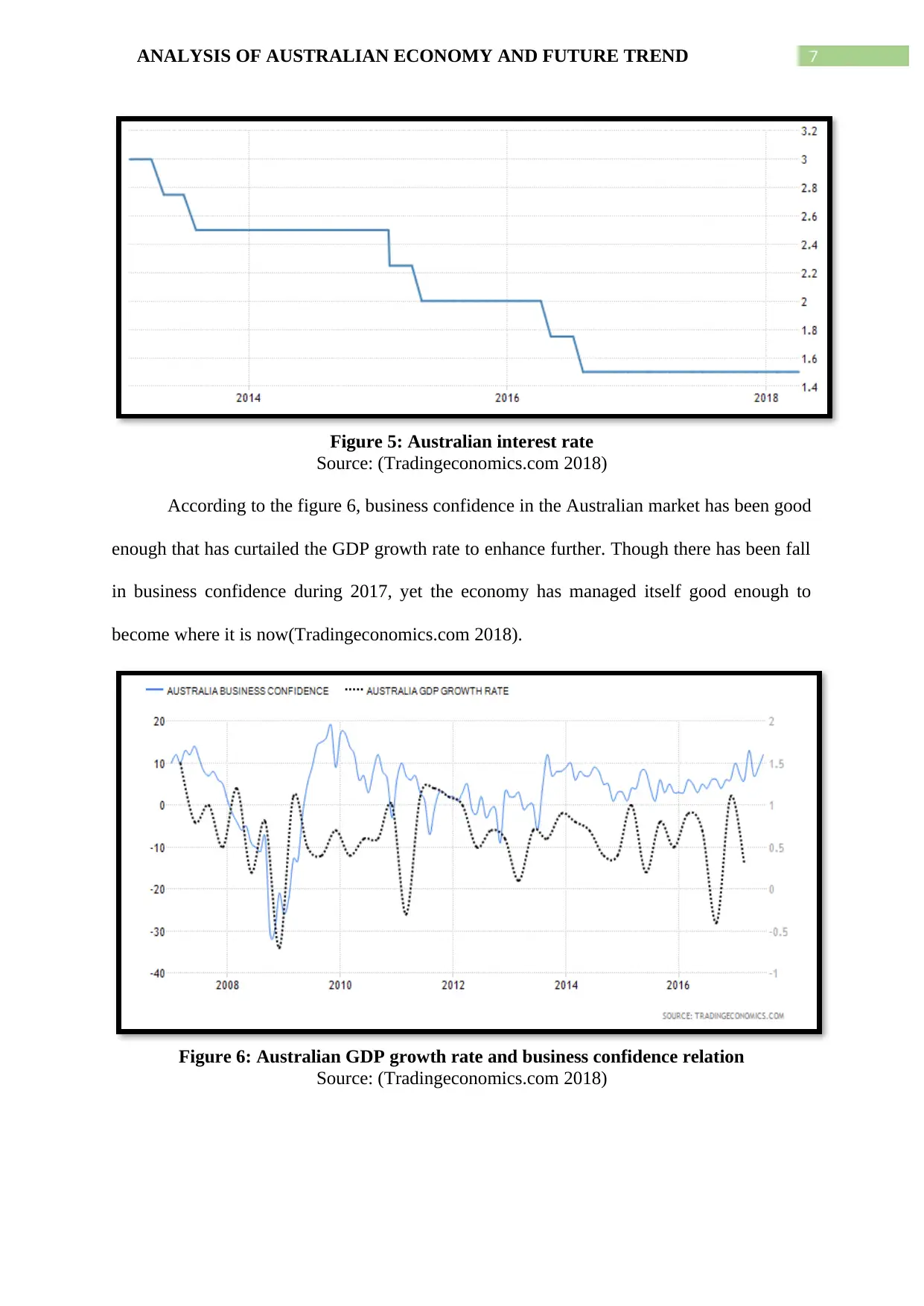
7ANALYSIS OF AUSTRALIAN ECONOMY AND FUTURE TREND
Figure 5: Australian interest rate
Source: (Tradingeconomics.com 2018)
According to the figure 6, business confidence in the Australian market has been good
enough that has curtailed the GDP growth rate to enhance further. Though there has been fall
in business confidence during 2017, yet the economy has managed itself good enough to
become where it is now(Tradingeconomics.com 2018).
Figure 6: Australian GDP growth rate and business confidence relation
Source: (Tradingeconomics.com 2018)
Figure 5: Australian interest rate
Source: (Tradingeconomics.com 2018)
According to the figure 6, business confidence in the Australian market has been good
enough that has curtailed the GDP growth rate to enhance further. Though there has been fall
in business confidence during 2017, yet the economy has managed itself good enough to
become where it is now(Tradingeconomics.com 2018).
Figure 6: Australian GDP growth rate and business confidence relation
Source: (Tradingeconomics.com 2018)
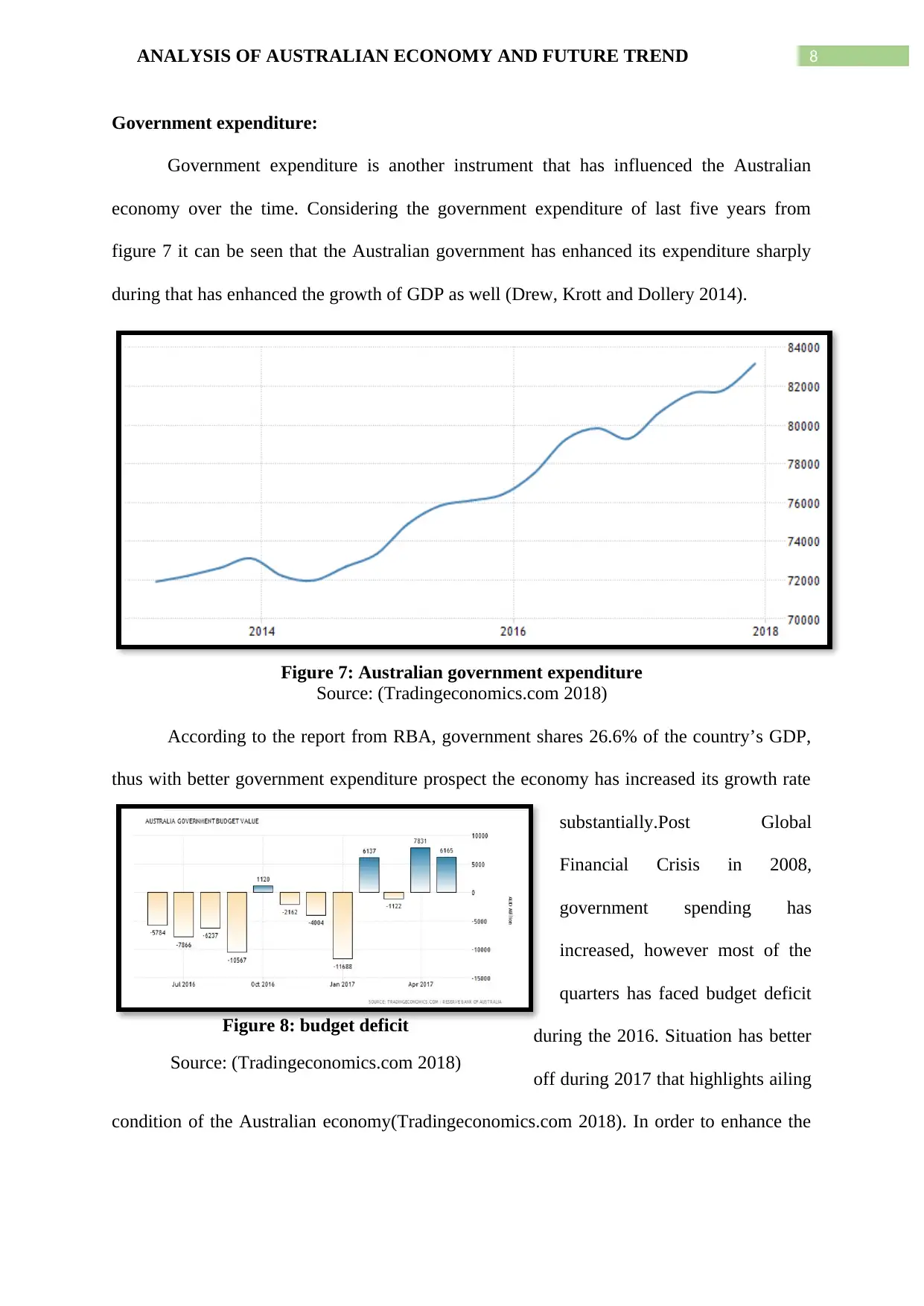
Figure 8: budget deficit
Source: (Tradingeconomics.com 2018)
8ANALYSIS OF AUSTRALIAN ECONOMY AND FUTURE TREND
Government expenditure:
Government expenditure is another instrument that has influenced the Australian
economy over the time. Considering the government expenditure of last five years from
figure 7 it can be seen that the Australian government has enhanced its expenditure sharply
during that has enhanced the growth of GDP as well (Drew, Krott and Dollery 2014).
Figure 7: Australian government expenditure
Source: (Tradingeconomics.com 2018)
According to the report from RBA, government shares 26.6% of the country’s GDP,
thus with better government expenditure prospect the economy has increased its growth rate
substantially.Post Global
Financial Crisis in 2008,
government spending has
increased, however most of the
quarters has faced budget deficit
during the 2016. Situation has better
off during 2017 that highlights ailing
condition of the Australian economy(Tradingeconomics.com 2018). In order to enhance the
Source: (Tradingeconomics.com 2018)
8ANALYSIS OF AUSTRALIAN ECONOMY AND FUTURE TREND
Government expenditure:
Government expenditure is another instrument that has influenced the Australian
economy over the time. Considering the government expenditure of last five years from
figure 7 it can be seen that the Australian government has enhanced its expenditure sharply
during that has enhanced the growth of GDP as well (Drew, Krott and Dollery 2014).
Figure 7: Australian government expenditure
Source: (Tradingeconomics.com 2018)
According to the report from RBA, government shares 26.6% of the country’s GDP,
thus with better government expenditure prospect the economy has increased its growth rate
substantially.Post Global
Financial Crisis in 2008,
government spending has
increased, however most of the
quarters has faced budget deficit
during the 2016. Situation has better
off during 2017 that highlights ailing
condition of the Australian economy(Tradingeconomics.com 2018). In order to enhance the
⊘ This is a preview!⊘
Do you want full access?
Subscribe today to unlock all pages.

Trusted by 1+ million students worldwide
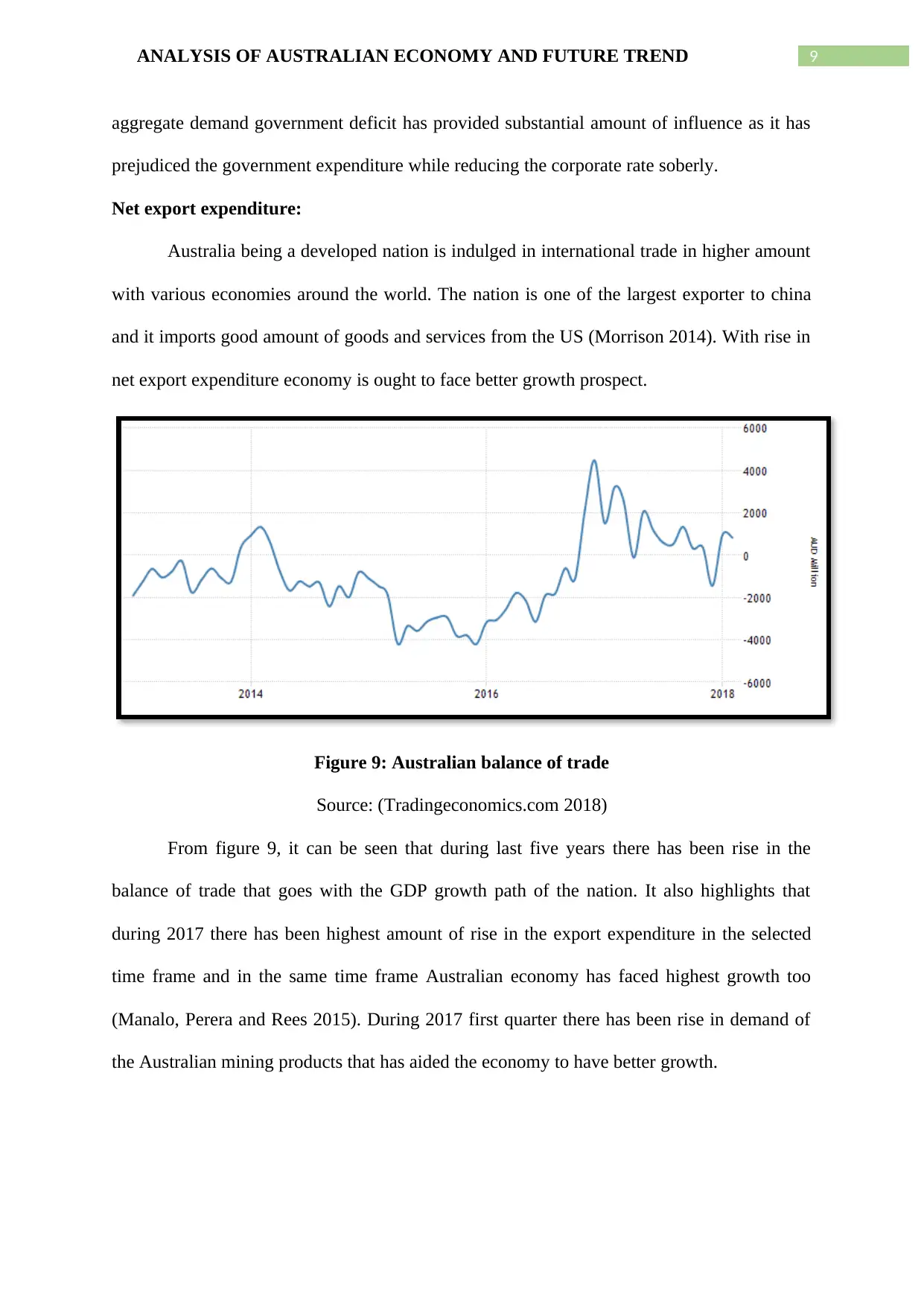
9ANALYSIS OF AUSTRALIAN ECONOMY AND FUTURE TREND
aggregate demand government deficit has provided substantial amount of influence as it has
prejudiced the government expenditure while reducing the corporate rate soberly.
Net export expenditure:
Australia being a developed nation is indulged in international trade in higher amount
with various economies around the world. The nation is one of the largest exporter to china
and it imports good amount of goods and services from the US (Morrison 2014). With rise in
net export expenditure economy is ought to face better growth prospect.
Figure 9: Australian balance of trade
Source: (Tradingeconomics.com 2018)
From figure 9, it can be seen that during last five years there has been rise in the
balance of trade that goes with the GDP growth path of the nation. It also highlights that
during 2017 there has been highest amount of rise in the export expenditure in the selected
time frame and in the same time frame Australian economy has faced highest growth too
(Manalo, Perera and Rees 2015). During 2017 first quarter there has been rise in demand of
the Australian mining products that has aided the economy to have better growth.
aggregate demand government deficit has provided substantial amount of influence as it has
prejudiced the government expenditure while reducing the corporate rate soberly.
Net export expenditure:
Australia being a developed nation is indulged in international trade in higher amount
with various economies around the world. The nation is one of the largest exporter to china
and it imports good amount of goods and services from the US (Morrison 2014). With rise in
net export expenditure economy is ought to face better growth prospect.
Figure 9: Australian balance of trade
Source: (Tradingeconomics.com 2018)
From figure 9, it can be seen that during last five years there has been rise in the
balance of trade that goes with the GDP growth path of the nation. It also highlights that
during 2017 there has been highest amount of rise in the export expenditure in the selected
time frame and in the same time frame Australian economy has faced highest growth too
(Manalo, Perera and Rees 2015). During 2017 first quarter there has been rise in demand of
the Australian mining products that has aided the economy to have better growth.
Paraphrase This Document
Need a fresh take? Get an instant paraphrase of this document with our AI Paraphraser

10ANALYSIS OF AUSTRALIAN ECONOMY AND FUTURE TREND
Trend analysis of Australian economy:
Australian economy is one of the growing western economy, which is set to face higher
growth in recent days due to government’s monetary expansion policy. According to the
forecast the economy is set to rise at 3% rate in next 6 months of the 2018(charts, 2018).
Though there has been fall in the growth rate since GFC in 2008; however, the economy is
now facing higher demand of mining product in the world market as well as government
expending and the consumption expenditure is on rise. Thus the economy is all set to face
higher growth in future.
Figure 10: Australian wage growth and inflation forecast
Source: (Tradingeconomics.com 2018)
Figure 10 highlights that the inflation of the nation is expected to rise to 3% to attain the
natural inflation rate, which can aid the economy to have better future growth prospect. In
addition to this, forecasted change rate of economy will remain between 3 to 2.5% that
highlights the higher growth prospect of the nation in coming 6 months (Rees, Smith and Hall
2016).
Trend analysis of Australian economy:
Australian economy is one of the growing western economy, which is set to face higher
growth in recent days due to government’s monetary expansion policy. According to the
forecast the economy is set to rise at 3% rate in next 6 months of the 2018(charts, 2018).
Though there has been fall in the growth rate since GFC in 2008; however, the economy is
now facing higher demand of mining product in the world market as well as government
expending and the consumption expenditure is on rise. Thus the economy is all set to face
higher growth in future.
Figure 10: Australian wage growth and inflation forecast
Source: (Tradingeconomics.com 2018)
Figure 10 highlights that the inflation of the nation is expected to rise to 3% to attain the
natural inflation rate, which can aid the economy to have better future growth prospect. In
addition to this, forecasted change rate of economy will remain between 3 to 2.5% that
highlights the higher growth prospect of the nation in coming 6 months (Rees, Smith and Hall
2016).
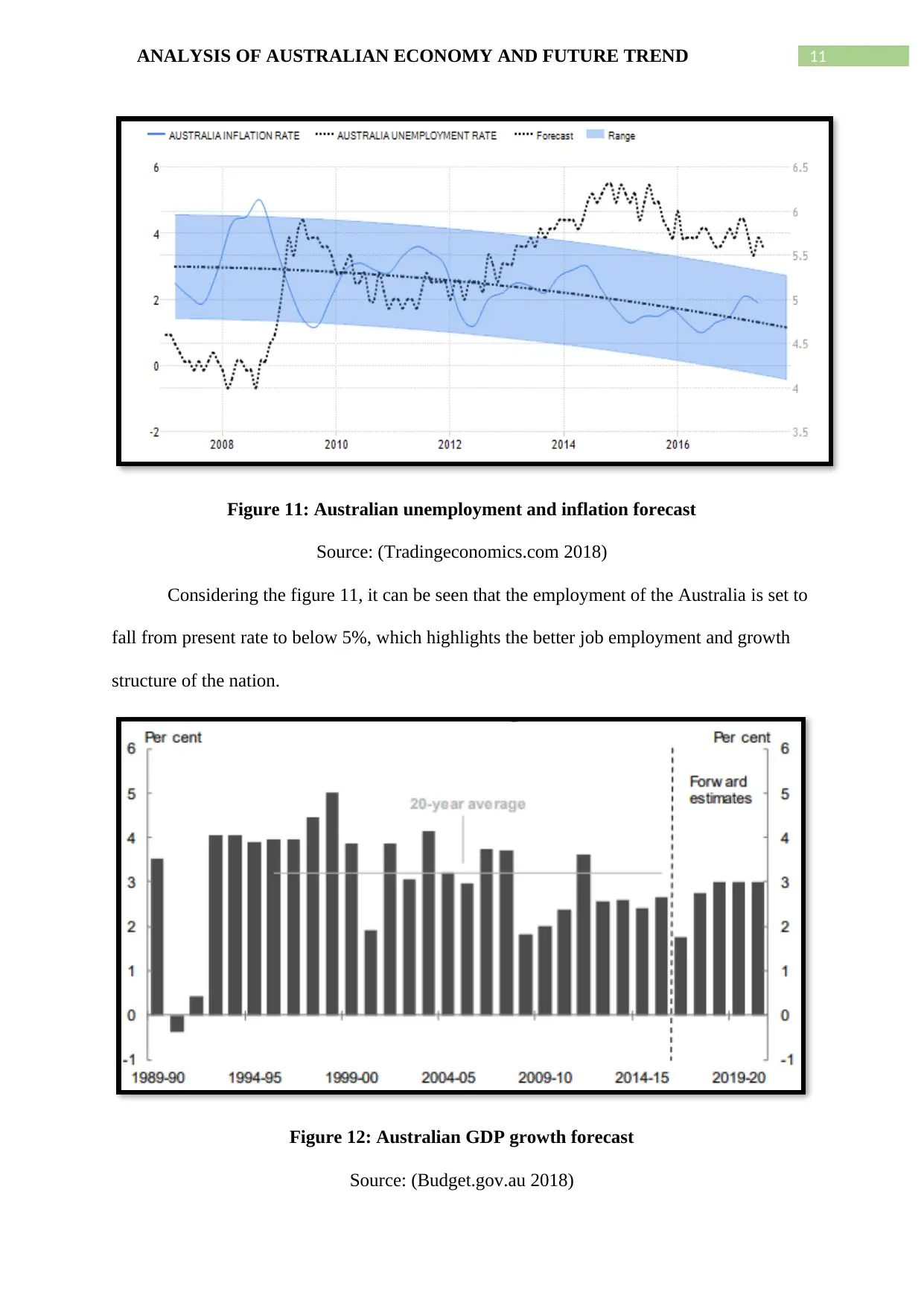
11ANALYSIS OF AUSTRALIAN ECONOMY AND FUTURE TREND
Figure 11: Australian unemployment and inflation forecast
Source: (Tradingeconomics.com 2018)
Considering the figure 11, it can be seen that the employment of the Australia is set to
fall from present rate to below 5%, which highlights the better job employment and growth
structure of the nation.
Figure 12: Australian GDP growth forecast
Source: (Budget.gov.au 2018)
Figure 11: Australian unemployment and inflation forecast
Source: (Tradingeconomics.com 2018)
Considering the figure 11, it can be seen that the employment of the Australia is set to
fall from present rate to below 5%, which highlights the better job employment and growth
structure of the nation.
Figure 12: Australian GDP growth forecast
Source: (Budget.gov.au 2018)
⊘ This is a preview!⊘
Do you want full access?
Subscribe today to unlock all pages.

Trusted by 1+ million students worldwide
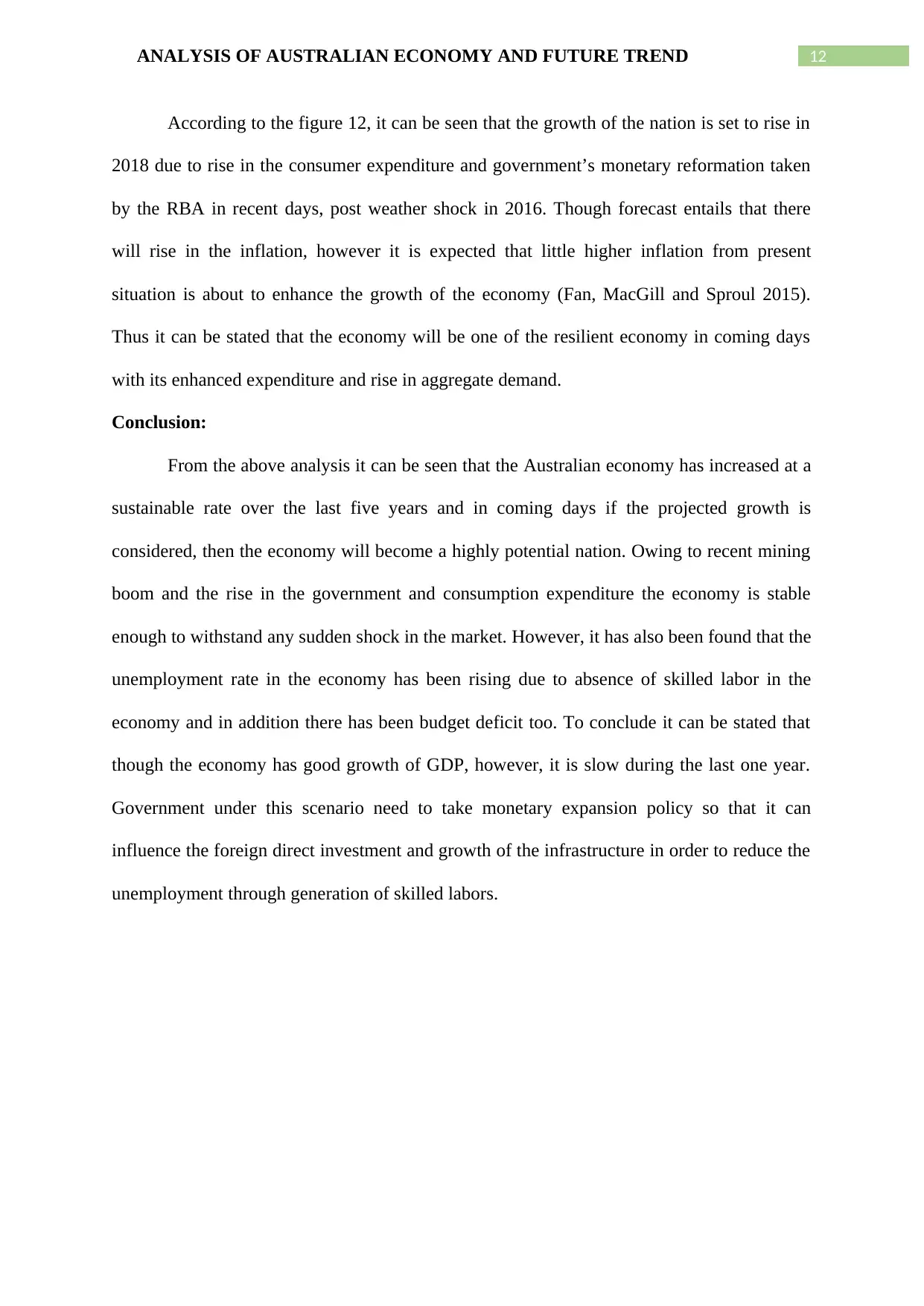
12ANALYSIS OF AUSTRALIAN ECONOMY AND FUTURE TREND
According to the figure 12, it can be seen that the growth of the nation is set to rise in
2018 due to rise in the consumer expenditure and government’s monetary reformation taken
by the RBA in recent days, post weather shock in 2016. Though forecast entails that there
will rise in the inflation, however it is expected that little higher inflation from present
situation is about to enhance the growth of the economy (Fan, MacGill and Sproul 2015).
Thus it can be stated that the economy will be one of the resilient economy in coming days
with its enhanced expenditure and rise in aggregate demand.
Conclusion:
From the above analysis it can be seen that the Australian economy has increased at a
sustainable rate over the last five years and in coming days if the projected growth is
considered, then the economy will become a highly potential nation. Owing to recent mining
boom and the rise in the government and consumption expenditure the economy is stable
enough to withstand any sudden shock in the market. However, it has also been found that the
unemployment rate in the economy has been rising due to absence of skilled labor in the
economy and in addition there has been budget deficit too. To conclude it can be stated that
though the economy has good growth of GDP, however, it is slow during the last one year.
Government under this scenario need to take monetary expansion policy so that it can
influence the foreign direct investment and growth of the infrastructure in order to reduce the
unemployment through generation of skilled labors.
According to the figure 12, it can be seen that the growth of the nation is set to rise in
2018 due to rise in the consumer expenditure and government’s monetary reformation taken
by the RBA in recent days, post weather shock in 2016. Though forecast entails that there
will rise in the inflation, however it is expected that little higher inflation from present
situation is about to enhance the growth of the economy (Fan, MacGill and Sproul 2015).
Thus it can be stated that the economy will be one of the resilient economy in coming days
with its enhanced expenditure and rise in aggregate demand.
Conclusion:
From the above analysis it can be seen that the Australian economy has increased at a
sustainable rate over the last five years and in coming days if the projected growth is
considered, then the economy will become a highly potential nation. Owing to recent mining
boom and the rise in the government and consumption expenditure the economy is stable
enough to withstand any sudden shock in the market. However, it has also been found that the
unemployment rate in the economy has been rising due to absence of skilled labor in the
economy and in addition there has been budget deficit too. To conclude it can be stated that
though the economy has good growth of GDP, however, it is slow during the last one year.
Government under this scenario need to take monetary expansion policy so that it can
influence the foreign direct investment and growth of the infrastructure in order to reduce the
unemployment through generation of skilled labors.
Paraphrase This Document
Need a fresh take? Get an instant paraphrase of this document with our AI Paraphraser
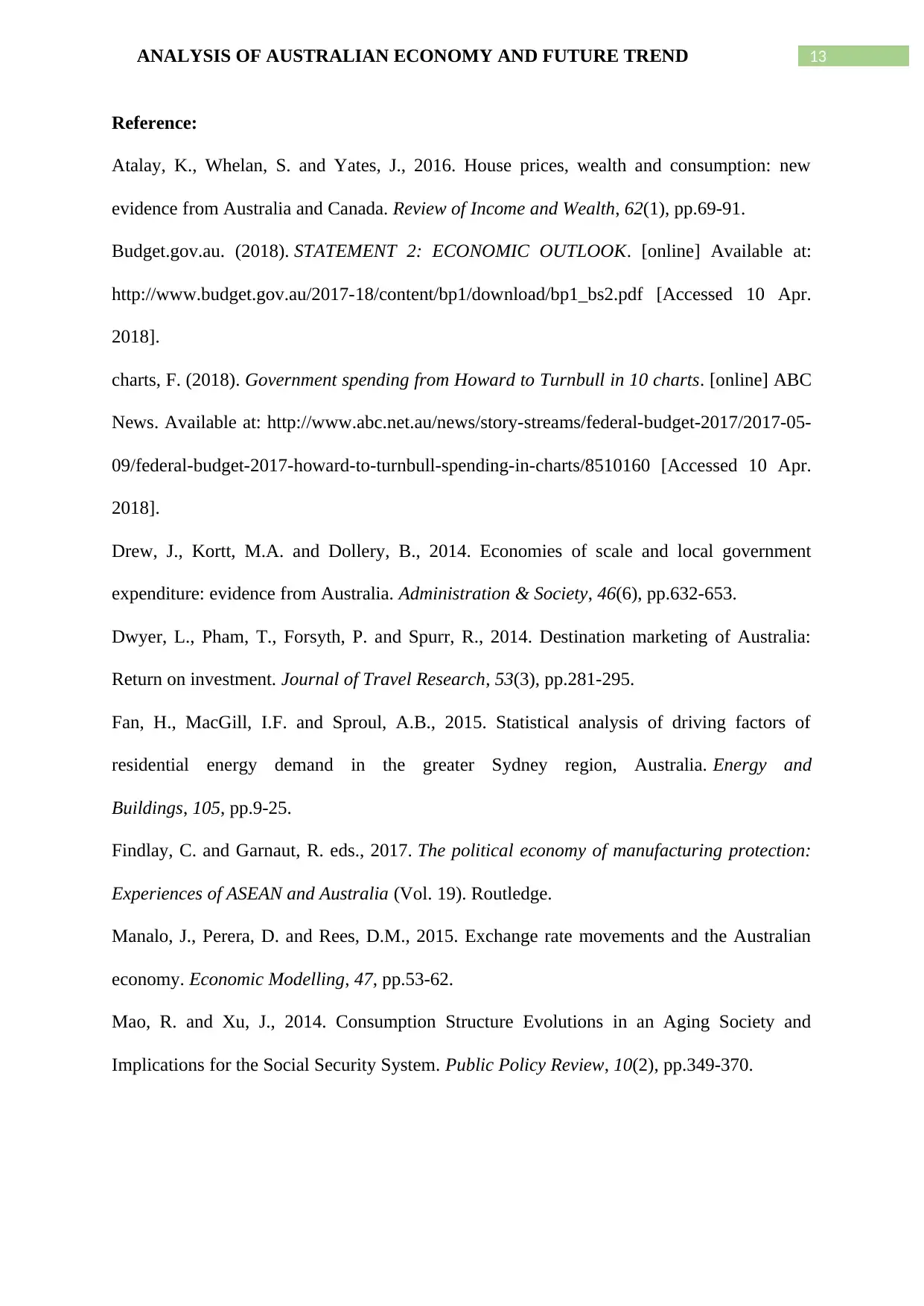
13ANALYSIS OF AUSTRALIAN ECONOMY AND FUTURE TREND
Reference:
Atalay, K., Whelan, S. and Yates, J., 2016. House prices, wealth and consumption: new
evidence from Australia and Canada. Review of Income and Wealth, 62(1), pp.69-91.
Budget.gov.au. (2018). STATEMENT 2: ECONOMIC OUTLOOK. [online] Available at:
http://www.budget.gov.au/2017-18/content/bp1/download/bp1_bs2.pdf [Accessed 10 Apr.
2018].
charts, F. (2018). Government spending from Howard to Turnbull in 10 charts. [online] ABC
News. Available at: http://www.abc.net.au/news/story-streams/federal-budget-2017/2017-05-
09/federal-budget-2017-howard-to-turnbull-spending-in-charts/8510160 [Accessed 10 Apr.
2018].
Drew, J., Kortt, M.A. and Dollery, B., 2014. Economies of scale and local government
expenditure: evidence from Australia. Administration & Society, 46(6), pp.632-653.
Dwyer, L., Pham, T., Forsyth, P. and Spurr, R., 2014. Destination marketing of Australia:
Return on investment. Journal of Travel Research, 53(3), pp.281-295.
Fan, H., MacGill, I.F. and Sproul, A.B., 2015. Statistical analysis of driving factors of
residential energy demand in the greater Sydney region, Australia. Energy and
Buildings, 105, pp.9-25.
Findlay, C. and Garnaut, R. eds., 2017. The political economy of manufacturing protection:
Experiences of ASEAN and Australia (Vol. 19). Routledge.
Manalo, J., Perera, D. and Rees, D.M., 2015. Exchange rate movements and the Australian
economy. Economic Modelling, 47, pp.53-62.
Mao, R. and Xu, J., 2014. Consumption Structure Evolutions in an Aging Society and
Implications for the Social Security System. Public Policy Review, 10(2), pp.349-370.
Reference:
Atalay, K., Whelan, S. and Yates, J., 2016. House prices, wealth and consumption: new
evidence from Australia and Canada. Review of Income and Wealth, 62(1), pp.69-91.
Budget.gov.au. (2018). STATEMENT 2: ECONOMIC OUTLOOK. [online] Available at:
http://www.budget.gov.au/2017-18/content/bp1/download/bp1_bs2.pdf [Accessed 10 Apr.
2018].
charts, F. (2018). Government spending from Howard to Turnbull in 10 charts. [online] ABC
News. Available at: http://www.abc.net.au/news/story-streams/federal-budget-2017/2017-05-
09/federal-budget-2017-howard-to-turnbull-spending-in-charts/8510160 [Accessed 10 Apr.
2018].
Drew, J., Kortt, M.A. and Dollery, B., 2014. Economies of scale and local government
expenditure: evidence from Australia. Administration & Society, 46(6), pp.632-653.
Dwyer, L., Pham, T., Forsyth, P. and Spurr, R., 2014. Destination marketing of Australia:
Return on investment. Journal of Travel Research, 53(3), pp.281-295.
Fan, H., MacGill, I.F. and Sproul, A.B., 2015. Statistical analysis of driving factors of
residential energy demand in the greater Sydney region, Australia. Energy and
Buildings, 105, pp.9-25.
Findlay, C. and Garnaut, R. eds., 2017. The political economy of manufacturing protection:
Experiences of ASEAN and Australia (Vol. 19). Routledge.
Manalo, J., Perera, D. and Rees, D.M., 2015. Exchange rate movements and the Australian
economy. Economic Modelling, 47, pp.53-62.
Mao, R. and Xu, J., 2014. Consumption Structure Evolutions in an Aging Society and
Implications for the Social Security System. Public Policy Review, 10(2), pp.349-370.
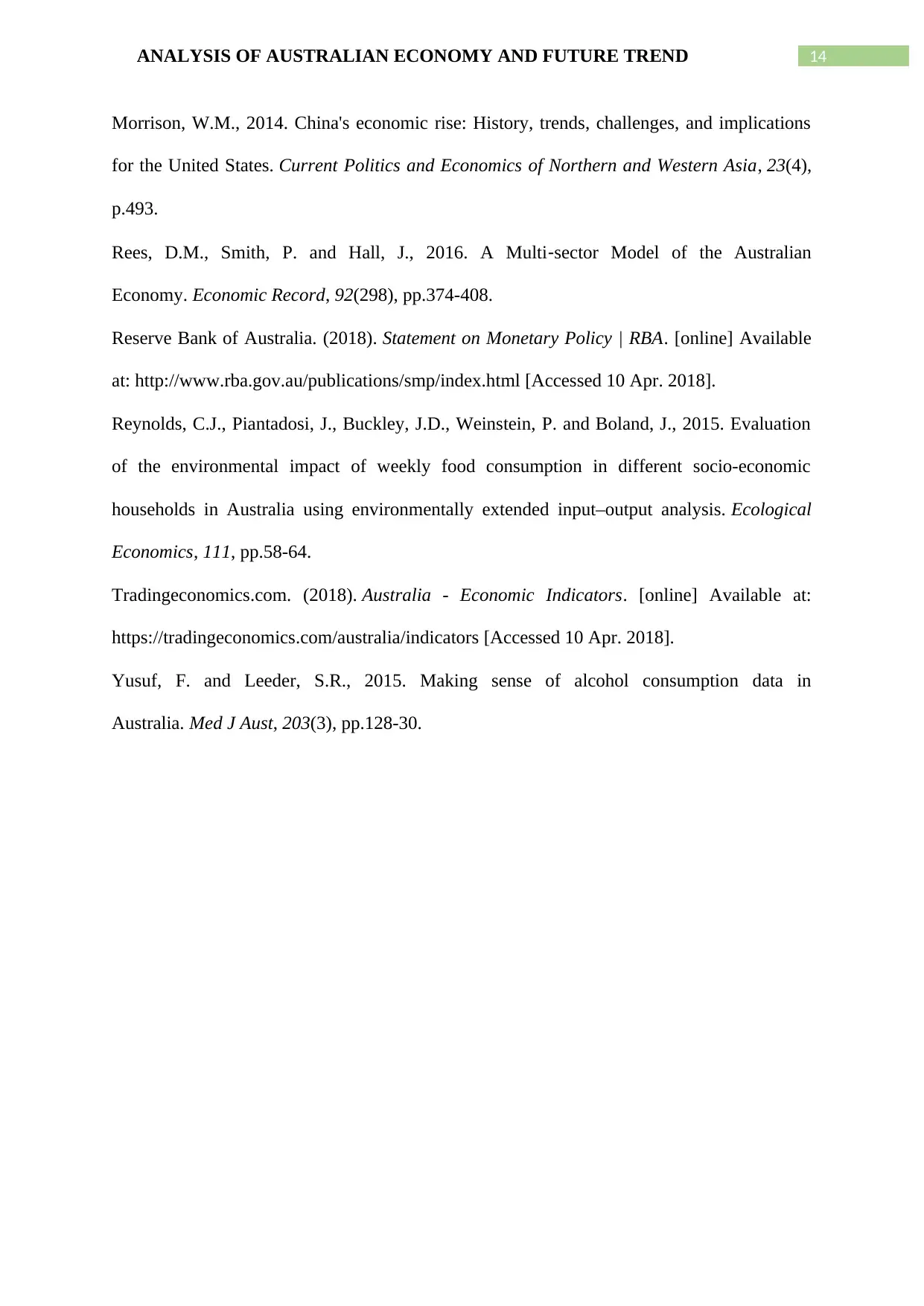
14ANALYSIS OF AUSTRALIAN ECONOMY AND FUTURE TREND
Morrison, W.M., 2014. China's economic rise: History, trends, challenges, and implications
for the United States. Current Politics and Economics of Northern and Western Asia, 23(4),
p.493.
Rees, D.M., Smith, P. and Hall, J., 2016. A Multi‐sector Model of the Australian
Economy. Economic Record, 92(298), pp.374-408.
Reserve Bank of Australia. (2018). Statement on Monetary Policy | RBA. [online] Available
at: http://www.rba.gov.au/publications/smp/index.html [Accessed 10 Apr. 2018].
Reynolds, C.J., Piantadosi, J., Buckley, J.D., Weinstein, P. and Boland, J., 2015. Evaluation
of the environmental impact of weekly food consumption in different socio-economic
households in Australia using environmentally extended input–output analysis. Ecological
Economics, 111, pp.58-64.
Tradingeconomics.com. (2018). Australia - Economic Indicators. [online] Available at:
https://tradingeconomics.com/australia/indicators [Accessed 10 Apr. 2018].
Yusuf, F. and Leeder, S.R., 2015. Making sense of alcohol consumption data in
Australia. Med J Aust, 203(3), pp.128-30.
Morrison, W.M., 2014. China's economic rise: History, trends, challenges, and implications
for the United States. Current Politics and Economics of Northern and Western Asia, 23(4),
p.493.
Rees, D.M., Smith, P. and Hall, J., 2016. A Multi‐sector Model of the Australian
Economy. Economic Record, 92(298), pp.374-408.
Reserve Bank of Australia. (2018). Statement on Monetary Policy | RBA. [online] Available
at: http://www.rba.gov.au/publications/smp/index.html [Accessed 10 Apr. 2018].
Reynolds, C.J., Piantadosi, J., Buckley, J.D., Weinstein, P. and Boland, J., 2015. Evaluation
of the environmental impact of weekly food consumption in different socio-economic
households in Australia using environmentally extended input–output analysis. Ecological
Economics, 111, pp.58-64.
Tradingeconomics.com. (2018). Australia - Economic Indicators. [online] Available at:
https://tradingeconomics.com/australia/indicators [Accessed 10 Apr. 2018].
Yusuf, F. and Leeder, S.R., 2015. Making sense of alcohol consumption data in
Australia. Med J Aust, 203(3), pp.128-30.
⊘ This is a preview!⊘
Do you want full access?
Subscribe today to unlock all pages.

Trusted by 1+ million students worldwide
1 out of 15
Related Documents
Your All-in-One AI-Powered Toolkit for Academic Success.
+13062052269
info@desklib.com
Available 24*7 on WhatsApp / Email
![[object Object]](/_next/static/media/star-bottom.7253800d.svg)
Unlock your academic potential
© 2024 | Zucol Services PVT LTD | All rights reserved.




